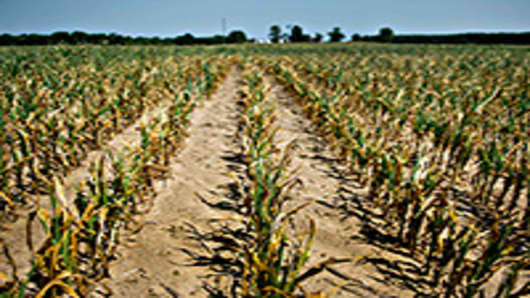Farmer Jerry Gulke was hoping for a record year. "I would be telling people this looks like the best crop I'm going to have in a long time, probably set the stage for a record," maybe even 200 bushels an acre, says the corn farmer in Rockford, IL.
Then the rain stopped falling.
"I would probably be pretty happy with this field if we had a hundred bushels," added Gulke.
The USDA slashed projections of corn production by a larger than expected amount, now predicting an average yield of 146 bushels an acre. "My concern is we're underestimating the scope of the problem," said Gulke, who also advises farmers on risk management tools like futures with The Gulke Group.
Many are comparing the Midwest drought with the one in 1988, when yields collapsed. But expensive drought tolerant seeds have come onto the market since then with promises of producing more bushels from less water. "We're going to find out from the genetics to see if they were worth the cost we put into it," Gulke said.
"This drought caught everyone by surprise," says Wyoming cattle rancher and trader Brett Crosby. "I think there is a better than 50 percent chance that we see $9-$10 corn."
Ranchers are turning to wheat to feed animals, but those prices are rising, too, and as for hay, Crosby went on to say, it is "virtually nonexistent."
The cut in supply is being met with a cut in demand, as the USDA projects lower exports for corn and soybeans, and less corn used for ethanol and livestock feed.
S&P lowered its rating on Smithfield Foods to Strong Sell from Hold. "We expect that hedging has protected SFD from some of the recent corn price, but we are still wary of future feed costs." Hog production accounts for 20 percent of the company's segment operating profits.
Farmers, ranchers and food manufacturers have been encouraged to use hedging tools to prevent being caught by catastrophe, but Jerry Gulke noted that many in agriculture shy away from them, especially after the MF Global scandal. What's more, a lot of buyers didn't lock in corn at $5/bushel because they thought it would go to $4. Instead, it's over $7 and climbing.
Gulke expects big public companies caught with higher costs will take cover under "this 'Act of God' thing, they'll blame Him for their inadequacies for management and didn't lock in prices."
Farmers and analysts are now wondering what the USDA will say next month, after the agency gets a better idea of how pollination of the corn crop went. In Illinois you can see tassels emerging from corn stalks holding pollen, which the wind knocks down to the developing ears below.
But on many stalks, the ears haven't developed, and the pollen will be wasted.
-By CNBC's Jane Wells
@JaneWells




